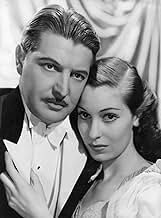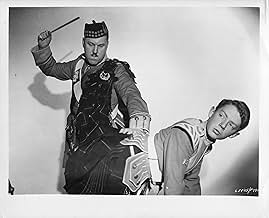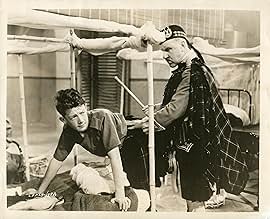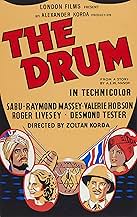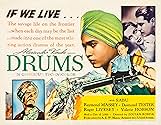PUNTUACIÓN EN IMDb
6,3/10
995
TU PUNTUACIÓN
El sanguinario jefe de unos fanáticos guerreros se presenta en la India y pone en jaque al ejército colonial británico. Pero, gracias a la valentía de un joven, las tropas inglesas podrán sa... Leer todoEl sanguinario jefe de unos fanáticos guerreros se presenta en la India y pone en jaque al ejército colonial británico. Pero, gracias a la valentía de un joven, las tropas inglesas podrán salvarse y devolver el trono a su legítimo herederoEl sanguinario jefe de unos fanáticos guerreros se presenta en la India y pone en jaque al ejército colonial británico. Pero, gracias a la valentía de un joven, las tropas inglesas podrán salvarse y devolver el trono a su legítimo heredero
- Dirección
- Guión
- Reparto principal
- Premios
- 1 premio y 1 nominación en total
Francis L. Sullivan
- Governor
- (as Francis L.Sullivan)
Laurence Baskcomb
- Zarullah
- (as Lawrence Baskcomb)
Julien Mitchell
- Sergeant
- (as Julian Mitchell)
Reseñas destacadas
Unabashedly pro-Raj, the story of a young Indian Prince and his friendship with some British army types. The release of this film was reported to have sparked anti-British riots in India. Sabu outdoes himself as the spunky and, ultimately, obsequious Prince who lines up with his friend/occupiers to battle the deliciously evil Raymond Massey. Very politically incorrect by today's standards the film is a good adventure yarn as well as a Korda tribute to the the rapidly vanishing British Empire. The plot borrows elements from the real life killing of Sir Louis Cavagnari and his party years earlier in Afghanistan. In reality British and colonial forces were actively engaged in military operations in Waziristan at the time of the making of the film.
In colonial India, the natives live happily and peacefully under the kind rule of their British masters. Representing the bond between the two nations, young Prince Azim befriends several of the British officers. However his uncle Ghul is less welcoming of the British and has dark plans to slaughter them and raise a rebellion among the tribes of the hills.
Some critics have pointed to the fact that, if this film were made today, it work spark outrage and be roundly condemned. This view ignores that, when the film was first screened in India in the late 30's, it sparked riots among the populace. However, the statement is true as well as being null and void, for there is zero danger of this film ever being made now! The plot is very pro-Empire and it is brazenly flag waving for the British. Looking back now, the film is laughable in it's depiction of it's characters. The British are kind and loving to all the Indians they encounter, while the Indians love them in return; those that don't are, of course, shifty and untrustworthy.
This is rather insulting if you think about it too much - I must admit I wasn't offended but then I am neither English or Indian and know little of the history that is clearly being twisted here in favour of propaganda. The film does have a nice vein of good humour to it though that prevents it being too heavy, while the battle scenes are of the `up'n'over' school of filming. The plot itself is too simplistic and can't keep the charade up - especially now that it will be clear to most viewers that it isn't a fair telling.
The cast are good, but again, there's no way that an `Indian' film would be shot today in Wales with the majority of the cast in blackface! The standout actor is Sabu. True his character is a little too good to be true but he has cheeky attitude and he is good fun throughout - just a shame his character seem to vanish for about a quarter of the film. The villainous Massey is also good fun and I enjoyed his performance. The British (namely Livesey and Hobson) are very stiff, although they do get the more heroic roles towards the end.
Overall this film is worth seeing as we will hopefully not see quite it's like again. The film is un-PC in casting, script, plot and characters, while the history it claims to tell is nothing more than a flag waving exercise that rightly started angry riots in Indian when it was shown there. However it is worth seeing for the period, the glorious (for the time) Technicolor and an amusing and fun performance from Sabu.
Some critics have pointed to the fact that, if this film were made today, it work spark outrage and be roundly condemned. This view ignores that, when the film was first screened in India in the late 30's, it sparked riots among the populace. However, the statement is true as well as being null and void, for there is zero danger of this film ever being made now! The plot is very pro-Empire and it is brazenly flag waving for the British. Looking back now, the film is laughable in it's depiction of it's characters. The British are kind and loving to all the Indians they encounter, while the Indians love them in return; those that don't are, of course, shifty and untrustworthy.
This is rather insulting if you think about it too much - I must admit I wasn't offended but then I am neither English or Indian and know little of the history that is clearly being twisted here in favour of propaganda. The film does have a nice vein of good humour to it though that prevents it being too heavy, while the battle scenes are of the `up'n'over' school of filming. The plot itself is too simplistic and can't keep the charade up - especially now that it will be clear to most viewers that it isn't a fair telling.
The cast are good, but again, there's no way that an `Indian' film would be shot today in Wales with the majority of the cast in blackface! The standout actor is Sabu. True his character is a little too good to be true but he has cheeky attitude and he is good fun throughout - just a shame his character seem to vanish for about a quarter of the film. The villainous Massey is also good fun and I enjoyed his performance. The British (namely Livesey and Hobson) are very stiff, although they do get the more heroic roles towards the end.
Overall this film is worth seeing as we will hopefully not see quite it's like again. The film is un-PC in casting, script, plot and characters, while the history it claims to tell is nothing more than a flag waving exercise that rightly started angry riots in Indian when it was shown there. However it is worth seeing for the period, the glorious (for the time) Technicolor and an amusing and fun performance from Sabu.
A wicked Khan plans to use THE DRUM perched high up in his palace walls to signal the massacre of British soldiers invited to a banquet.
Sir Alexander Korda's London Films was responsible for this lively Technicolor action film which boasted outdoor scenes shot near the North-West Frontier with the assistance of the Mehtar of Chitral. It blends excitement, humor & history - definitely from a British viewpoint - into an attractive package sure to entertain the viewer lucky enough to find it.
Indian actor Sabu stars as the young Prince of Tokot who finds his life suddenly become very dangerous when he's forced to flee his usurping uncle and accept protection from the British Raj. Plummy-voiced Roger Livesey plays the Raj's stalwart envoy to Tokot who must find a way to stop the import of weapons to the evil new Khan, Raymond Massey, who is fomenting a rebellion. All three actors play their parts very well, with Massey especially attacking his villainous role with gusto.
Also in the cast are Valerie Hobson as Livesey's courageous wife; David Tree as a junior officer; and corpulent Francis L. Sullivan as the local Governor in Peshawar. Alfred Goddard appears unbilled as the hapless private Kelly.
*************************
Born Sabu Dastagir in 1924, Sabu was employed in the Maharaja of Mysore's stables when he was discovered by Korda's company and set before the cameras. His first four films (ELEPHANT BOY-1937, THE DRUM-1938, THE THIEF OF BAGDAD-1940, JUNGLE BOOK-1942) were his best and he found himself working out of Hollywood when they were completed. After distinguished military service in World War II he resumed his film career, but he became endlessly confined for years playing ethnic roles in undistinguished minor films, BLACK NARCISSUS (1947) being the one great exception. His final movie, Walt Disney's A TIGER WALKS (1964) was an improvement, but it was too late. Sabu had died of a heart attack in late 1963, only 39 years of age.
Sir Alexander Korda's London Films was responsible for this lively Technicolor action film which boasted outdoor scenes shot near the North-West Frontier with the assistance of the Mehtar of Chitral. It blends excitement, humor & history - definitely from a British viewpoint - into an attractive package sure to entertain the viewer lucky enough to find it.
Indian actor Sabu stars as the young Prince of Tokot who finds his life suddenly become very dangerous when he's forced to flee his usurping uncle and accept protection from the British Raj. Plummy-voiced Roger Livesey plays the Raj's stalwart envoy to Tokot who must find a way to stop the import of weapons to the evil new Khan, Raymond Massey, who is fomenting a rebellion. All three actors play their parts very well, with Massey especially attacking his villainous role with gusto.
Also in the cast are Valerie Hobson as Livesey's courageous wife; David Tree as a junior officer; and corpulent Francis L. Sullivan as the local Governor in Peshawar. Alfred Goddard appears unbilled as the hapless private Kelly.
*************************
Born Sabu Dastagir in 1924, Sabu was employed in the Maharaja of Mysore's stables when he was discovered by Korda's company and set before the cameras. His first four films (ELEPHANT BOY-1937, THE DRUM-1938, THE THIEF OF BAGDAD-1940, JUNGLE BOOK-1942) were his best and he found himself working out of Hollywood when they were completed. After distinguished military service in World War II he resumed his film career, but he became endlessly confined for years playing ethnic roles in undistinguished minor films, BLACK NARCISSUS (1947) being the one great exception. His final movie, Walt Disney's A TIGER WALKS (1964) was an improvement, but it was too late. Sabu had died of a heart attack in late 1963, only 39 years of age.
Plot-- British colonial rule in parts of India is imperiled by the murder of the local monarch by his sinister brother (Massey). Now the British contingent (Livesey, Hobson, et al.) must rely on the young pro-British nephew (Sabu) to rally against the usurper.
As a boy growing up in a small mid-western town, I never missed this epic and its companion feature Four Feathers (1939) in our theater. After all, where else in pre-TV middle America could all that scenic exotica be seen. The be-turbaned Indian natives, the be-skirted English soldiers, the high mountain passes, all in rich Technicolor, along with the rich pageantry of masses of people moving here and there. And shouldn't forget the crackling, if somewhat clichéd, storyline, along with a charmingly youthful Sabu, a gloweringly sinister Raymond Massey, and a slim, long-limbed Valerie Hobson. Then there's that thundering drum, along with slinky native girls and twirling British Highlanders. The Korda's certainly spared no expense and it shows, from spirited opening to satisfying close. Sure, the subtext amounts to British colonial propaganda that no longer wears well. Still, the lavish spectacle remains, a treat for the eye. Of course, I've changed in many ways from those earlier days, but the Korda production can still entertain and impress, if given half a chance.
As a boy growing up in a small mid-western town, I never missed this epic and its companion feature Four Feathers (1939) in our theater. After all, where else in pre-TV middle America could all that scenic exotica be seen. The be-turbaned Indian natives, the be-skirted English soldiers, the high mountain passes, all in rich Technicolor, along with the rich pageantry of masses of people moving here and there. And shouldn't forget the crackling, if somewhat clichéd, storyline, along with a charmingly youthful Sabu, a gloweringly sinister Raymond Massey, and a slim, long-limbed Valerie Hobson. Then there's that thundering drum, along with slinky native girls and twirling British Highlanders. The Korda's certainly spared no expense and it shows, from spirited opening to satisfying close. Sure, the subtext amounts to British colonial propaganda that no longer wears well. Still, the lavish spectacle remains, a treat for the eye. Of course, I've changed in many ways from those earlier days, but the Korda production can still entertain and impress, if given half a chance.
Fun little movie that depicts the British and Indians living in some sort of Utopia together, with an evil villain (Raymond Massey, hamming it up with a vengeance) planning to slaughter the British troops at a banquet. It's up to his prince nephew, Sabu--the greatest of all child actors--to stop him. Definitely politically incorrect (although not outright racist), but with a lot of heart and humor. The humor disappears at the end in place of heavy suspense, and it's all wrapped up with a rousing, drawn-out battle scene. Hey, any movie with Scottish highlanders singing around a campfire is worth watching if you ask me. And it's in Technicolor to boot. 7/10.
¿Sabías que...?
- CuriosidadesThe film caused protests when shown in Bombay and Madras, as it was considered by many to be British propaganda.
- Versiones alternativasVersion shown on Turner Classic Movies from "The Criterion Collection" runs 93 minutes
- ConexionesFeatured in Family Classics: Family Classics: The Drum (1964)
Selecciones populares
Inicia sesión para calificar y añadir a tu lista para recibir recomendaciones personalizadas
- How long is The Drum?Con tecnología de Alexa
Detalles
- Duración
- 1h 44min(104 min)
- Relación de aspecto
- 1.37 : 1
Contribuir a esta página
Sugerir un cambio o añadir el contenido que falta

